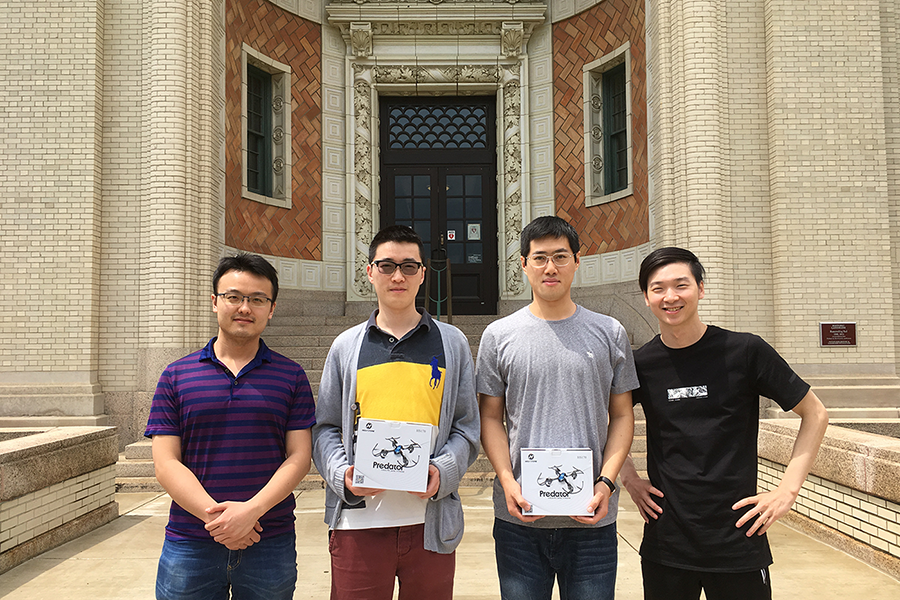
“Circling the block” may soon be circling the drain
Everyone who drives in the city knows the pain of looking for a parking spot. With the majority of spots in most cities located in free or metered on-street parking areas, drivers can spend considerable time and effort circling aimlessly, searching for a spot near their destination. In fact, an analysis by UCLA Professor and parking expert Donald Shoup of a collection of 10 studies concluded that parking accounts for around 30 percent of traffic congestion in urban areas. Extra minutes spent searching for parking costs not only those parking, but every driver within the area, untold amounts of time, effort, and gas every year.
One team of ECE Ph.D. students aims to make aimless coasting for parking a thing of the past. The students, all advised by Professor Diana Marculescu, debuted their idea at the Siemens FutureMakers Challenge. The hack-a-thon style challenge gave students 24 hours to devise a novel application for artificial intelligence, create a basic demonstration of their idea, and present it before a panel of judges from Siemens. The team, consisting of Ph.D. students Zhuo Chen, Ermao Cai, Ruizhou Ding, and Ting-Wu Chin, took third place in the competition with their project, dubbed ParkAI.
The group conceptualizes ParkAI as an app which could cut down on the time it takes drivers to find an on-street parking spot by at least 86 percent. While most current parking apps focus on garage parking—relatively easy to monitor given that garages are gated and can keep a running tally of how many cars enter and exit—the ParkAI team chose to focus on on-street parking. On-street parking presents several unique challenges, with few areas equipped with sensors, and spots often only staying open for a matter of minutes, or even seconds.
To counter these obstacles, ParkAI’s algorithm is designed to pull data from both parking meters and users. Drawing inferences from meter data, it can notify users when a spot opens up, while user data allows the machine learning algorithm to infer information about parking spots in areas that fall outside of meter coverage.
“There is research trying to figure out this information by planting sensors all over the place, but this would cost billions of dollars,” says Chen. “Our approach doesn’t require that, which gives us a competitive edge.”
Although the app itself is still in the conceptual phase, the ParkAI team has demonstrated that their algorithm can combine this data to route drivers to the best available spot based on price and proximity to their destination. The algorithm is also flexible and easily adaptable to variations in road layout and traffic conditions. Also, as Chen notes, because the algorithm relies on user data, it becomes more effective the more users there are.
The benefits which the team’s app could one day provide extend past saving drivers time. Cutting down on time spent cruising around the block could also have a significant environmental impact, decreasing the amount of greenhouse gasses entering the atmosphere by reducing fuel consumption. Furthermore, it may help inform the way urban planners and transportation engineers design and locate parking areas.
The team’s next steps will revolve around building the app itself and fine-tuning their algorithm to further optimize parking time. The team believes there is room to improve their current model by a factor of ten. The main challenge they face is scaling their small-scale test model up to meet the rigors of a large-scale urban environment. They plan to tackle this roadblock by breaking said environments into smaller compartmentalized areas, tailoring ParkAI’s functionality to each in a divide-and-conquer approach.
The team’s ultimate goal is to create a fully functional app with a two-tiered membership model.
“Data is a very limited resource. A spot could be gone within a few minutes or even seconds. In our current business plan, we separate customers into two categories: paid and free,” says Cai. “For the paid plan we can provide a finer-grain update for parking spots and availabilities. And for the free one we may provide a coarser-grain update. Maybe for the paid version, we provide them with one update per second, but for free users, we give updates every minute. This way we can relieve the workload and the burden on the servers.”
It may still be a while yet before the ParkAI teams’ business is ready to hit the streets, but their work signals the beginning of the end for traditional parking—and all of its hassles.
“We believe that this is a real problem that plagues every driver, including students like us, and other drivers without parking permits,” says Chen. “We want to solve this so we can save them time and money, and hopefully improve traffic and the environment.”